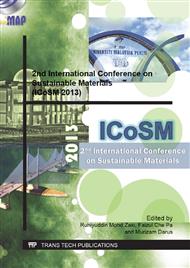p.170
p.174
p.182
p.190
p.195
p.201
p.206
p.211
p.219
The Effect of Iron Fillings Waste Contents on the Attenuation Level of Anti-Radiation Shielding Concrete
Abstract:
Shielding concretes of different iron filling contents were assessed for their anti radiation attenuation properties. The measurements have been performed by using gamma spectrometer of NaI (Tl) detector, the sources were Cs137 and Co60 radioactive elements with photon energies of o.662 MeV, for Cs137 and the two 1.17MeV, 1.33 MeV energy levels for the Co60. Likewise, the mean free path of the tested samples was obtained as well. From the measurement of the linear attenuation coefficients for these different shielding materials, it was found that as the iron filings within the concrete are increased the linear attenuation coefficient is increased also. It can be concluded from this work that the Iron filings content in concrete is very effective in augmentation of the anti-radiation shielding capability. It can be used as shelters material for secure storing of the nuclear wastes.
Info:
Periodical:
Pages:
195-200
Citation:
Online since:
September 2013
Price:
Сopyright:
© 2013 Trans Tech Publications Ltd. All Rights Reserved
Share:
Citation:


